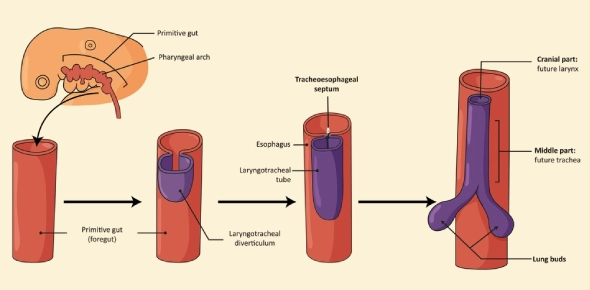Development of the Respiratory System From Lung Bud to Life-Sustaining Breath
Lesson Overview
- Origin of the Respiratory System
- Separation of Trachea and Esophagus
- Developmental Timeline of the Respiratory System
- Branching and Segmentation
- Formation of Pleural Cavities and Diaphragm
- The Five Stages of Lung Development
- Surfactant: The Key to Survival
- Fetal Breathing and Postnatal Transition
- Common Disorders Related to Development
- Teacher Tips & Memory Aids
- Key Takeaway
Imagine the moment a newborn takes its first breath-air fills the lungs that were once full of fluid. This ability hinges on a complex and timed development of the respiratory system, beginning as early as the fourth week of embryogenesis.

In this lesson, we'll cover how the respiratory system forms, matures, and prepares for function at birth, aligning closely with learning expectations.
Origin of the Respiratory System
The respiratory system originates from the foregut endoderm. Around week 4, an outgrowth called the respiratory diverticulum or lung bud emerges from the ventral wall of the foregut.
- Epithelium of the larynx, trachea, bronchi, and lungs originates from the endoderm.
- Muscles, cartilage, and connective tissues derive from the splanchnic mesoderm surrounding the foregut.
Key Point: This dual origin explains the structural and functional division between the lining and supporting tissues.
Separation of Trachea and Esophagus
Initially, the lung bud is in open communication with the foregut. A wall called the tracheoesophageal septum forms, dividing the tube into:
- Dorsal portion → Esophagus
- Ventral portion → Trachea and lung buds
Defect Example: Incomplete separation may result in a tracheoesophageal fistula (TEF), often with esophageal atresia, causing polyhydramnios due to inability to swallow amniotic fluid.
Developmental Timeline of the Respiratory System
Below is a developmental timeline with key features of each stage:
| Stage | Weeks (Gestation) | Key Features |
| Embryonic | 4–7 | Lung bud formation, primary bronchial branching |
| Pseudoglandular | 5–16 | Formation of terminal bronchioles, no alveoli, no gas exchange |
| Canalicular | 16–26 | Respiratory bronchioles form, capillaries develop, limited gas exchange possible |
| Saccular (Terminal Sac) | 26–36 | Terminal sacs (primitive alveoli), surfactant production increases |
| Alveolar | 36 weeks to 8 years | Alveolar maturation and multiplication |
Branching and Segmentation
Lung development proceeds via sequential branching:
- Primary bronchi → Right and left lung
- Secondary bronchi → Each lung lobe (3 on right, 2 on left)
- Tertiary bronchi → Form bronchopulmonary segments, the largest anatomical subdivision of lung lobes.
Each bronchopulmonary segment has its own:
- Bronchus
- Artery and vein
- Connective tissue capsule
(This allows for surgical resection of segments when needed.)
Formation of Pleural Cavities and Diaphragm
During the 4th week, the pericardioperitoneal canals link the thoracic and abdominal cavities. The diaphragm forms from:
- Septum transversum
- Pleuroperitoneal membranes
- Dorsal mesentery
- Body wall musculature
Splanchnic mesoderm forms the visceral pleura, and somatic mesoderm forms the parietal pleura.
Clinical Note:
- Congenital diaphragmatic hernia (CDH) results from failed closure of the pleuroperitoneal folds.
- Pulmonary hypoplasia in CDH determines survival chances.
The Five Stages of Lung Development
1. Embryonic Stage (4–7 weeks)
- Lung bud forms → Primary and secondary bronchi
- Respiratory diverticulum separates from the foregut
- Initial development of pleural cavities
2. Pseudoglandular Stage (5–16 weeks)
- Branching continues to terminal bronchioles
- Lung appears like a gland histologically
- No respiratory bronchioles or alveoli → Not viable if born
3. Canalicular Stage (16–26 weeks)
- Respiratory bronchioles and alveolar ducts form
- Capillaries approach epithelium
- Type II pneumocytes appear (~20–24 weeks), begin secreting surfactant
- Limited gas exchange → Threshold of viability ~24–26 weeks
4. Saccular Stage (26–36 weeks)
- Formation of terminal sacs (primitive alveoli)
- Capillaries align closely with alveolar epithelium
- Surfactant production increases significantly around week 28
5. Alveolar Stage (36 weeks to ~8 years)
- Mature alveoli develop via septation
- Only 1/6 of adult alveoli present at birth
- Alveoli multiply until around age 8
Surfactant: The Key to Survival
Produced by Type II pneumocytes, surfactant reduces surface tension in alveoli, preventing collapse (atelectasis) during expiration.
| Milestone | Timing |
| Type II pneumocytes appear | ~20–22 weeks |
| Surfactant production begins | ~24 weeks |
| Significant production | ~28 weeks |
| Lung maturity (usually sufficient for life) | ~35 weeks |
Deficiency Consequence:
- Respiratory Distress Syndrome (RDS) in preterm infants
- Managed with glucocorticoids (prenatally) or artificial surfactant (postnatally)
Fetal Breathing and Postnatal Transition
Fetal Breathing Movements
- Begin before birth, not at birth
- Involve inhalation and exhalation of amniotic fluid
- Function: Stimulate lung growth and condition respiratory muscles
At Birth
- Lung fluid is absorbed by blood and lymph capillaries
- Air replaces fluid during first breaths
- Surfactant ensures alveoli remain open
Common Disorders Related to Development
| Disorder | Cause/Stage Affected | Outcome |
| TEF with esophageal atresia | Incomplete foregut separation | Polyhydramnios, feeding difficulties |
| Congenital Diaphragmatic Hernia (CDH) | Failure of pleuroperitoneal membrane closure | Pulmonary hypoplasia |
| Respiratory Distress Syndrome (RDS) | Surfactant deficiency | Alveolar collapse, requires intervention |
| Congenital Lung Cysts | Abnormal dilation of bronchioles | Honeycomb appearance on radiograph |
Teacher Tips & Memory Aids
- Mnemonic for lung stages:
Every Pulmonologist Can See Alveoli
(Embryonic, Pseudoglandular, Canalicular, Saccular, Alveolar) - Embryonic origin trick:
Epithelium from Endoderm
Muscle/Cartilage from Mesoderm - Quiz Alert: Know the week surfactant starts (24), surges (28), and lungs mature (35).
Key Takeaway
The development of the respiratory system is a highly orchestrated process, crucial for the survival of newborns. Understanding this process-from the early appearance of the lung bud to the late development of alveoli. By integrating embryology with functional outcomes, students grasp both the complexity and clinical relevance of respiratory development.
Take this Quiz:
Rate this lesson:
 Back to top
Back to top
